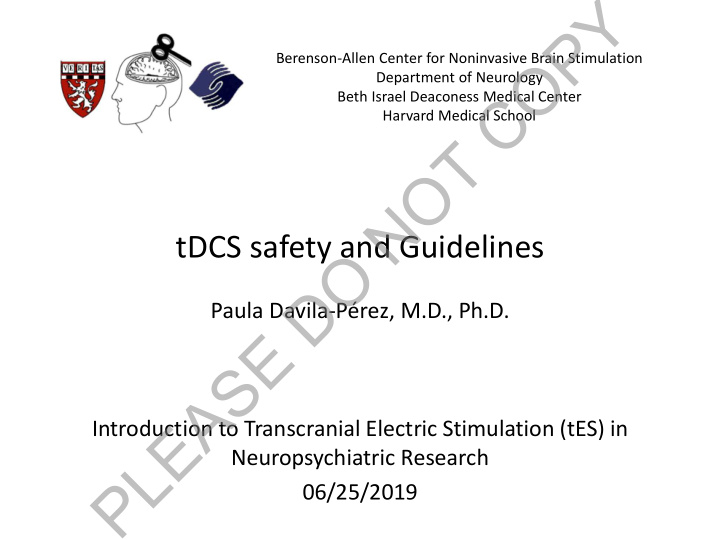



Y P O Berenson-Allen Center for Noninvasive Brain Stimulation Department of Neurology C Beth Israel Deaconess Medical Center Harvard Medical School T O N tDCS safety and Guidelines O D Paula Davila-Pérez, M.D., Ph.D. E S A E Introduction to Transcranial Electric Stimulation (tES) in L Neuropsychiatric Research P 06/25/2019
Y P Is tDCS Safe? O C YES! T When applied in accordance with safety guidelines and reviews O N O D E S A E L P http://www.ifcn.info/
Y P O tDCS device C T O N Cables and sponges O D E S Montage and A E Safe parameters L P
Y P tDCS device O C T O • Automatic Current Ramping N • Current Fluctuation During Stimulation O – Display of Actual Current D E • Impedance Check / beep and stop S • Current Spiking During Device On/Off A E L P
Y P Cables and sponges O C T O Always use Saline. N O Possible alternatives: D E - Electrode gel or cream S A E L P Tap water is not recommended
Y P Cables and sponges O C T • Broken cables O N • Rust and corrosion O D • Old/Dried out sponges E S • Moisture of sponges A Be careful, no dripping! E L P
Y P O Montage and Safe parameters C T O Electrodes should make uniform contact with the scalp N O Current intensity: 1 – 2 mA (< 4 mA) D Duration: 10 – 20 min/day (up to 60 min/day) E S Electrode area: 25 – 35 cm 2 (1 to 100cm 2 ) A E L P Abrading the skin before placing the electrode is not recommended (Loo et al. 2011)
Y P Safety limits and animal studies O C Current intensity T O Duration N Electrode area O D E S A E L Liebetanz et al, 2009 P
Y P Safety limits and animal studies O C Current intensity T O Duration N Electrode area O D E S A E L Liebetanz et al, 2009 P
Y P Is tDCS Safe? O C T YES! O N When applied in accordance with safety guidelines and reviews O D BUT… E Mild and moderate Adverse Events (AEs) may happen S A E L P
Y P O C T O N O D • Systematic review of reported adverse events (AEs) in patients and healthy subjects: E S – 172 articles (209 studies) included A – 117 studies assessed AEs E L – 74 studies reported at least 1 AE P
Y P O C T O N O Mild AEs are the most commonly reported D – Itching (39.3%) E S – Tingling (22.2%) A – Headache (14.8%) E – Discomfort (10.4%) L P – Burning sensation (8.7%)
Y P Skin redness and burn O C T O Wang et al. 2015 N Healthy subject O Single session D 2 mA, 26 min, 35 cm 2 E S A E The sponges were too old Skin abrading prior to tDCS L P Uneven current distribution
Y P Skin burn O C Palm et al. 2008 T 10 Patients, multiple O sessions N 1 mA, 20 min, 35 cm 2 O Skin redness D 5 Patients, multiple E sessions 2 mA, 20 min, 35 cm 2 S A Skin burns E L Tap water instead of Saline P
Y P Contact dermatitis O C Riedel et al. 2008 T O Healthy subject N Single session O 0.75 mA D 20 min Anode 100 cm 2 E Cathode 9cm2 S Skin irritation and pruritus A 2 days after the stimulation E L P Probable allergic reaction
Y P Additional considerations O C • Screening questionnaire: T O – Metal or electronic implants in the brain/skull or elsewhere N – Brain or spinal cord surgery O D – Head trauma with impairment of consciousness E – Skin problems (dermatitis, eczema...) S – History of epilepsy A E – Pregnancy L – Medications P
Y P Additional considerations O C • Safety in children T O – Reported AEs are the same as in adults – Thinner skulls, thus less resistance and greater amount of N current O D • Safety during pregnancy – Research: Questionnaires should ask about pregnancy E – Clinical practice: Only when benefit is higher than risk S A • Safety in older age E – Reported AEs are the same as in young adults L – Cortical atrophy in age-related diseases P
Y P tDCS modeling in the brain O C T O Young healthy controls N O D Older healthy controls E S Mild cognitive impairment A E L P Mahdavi et al., 2017
Y P O C T O N O D Skull E S defect A E L P
Y P O C T O N O D E S A E Datta, 2010 L P
Y P Safety Recommendations O C T • Always screen for exclusion criteria and AEs O N • Follow guidelines recommendations O D • Verify safety montage and setup parameters E • Consider environment (ex. Hospital/University) S and plan emergency procedures accordingly A E L • Keep informed of new safety guidelines P
Recommend
More recommend